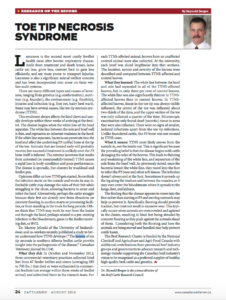Toe Tip Necrosis Syndrome
This article written by Dr. Reynold Bergen, BCRC Science Director, originally appeared in the August 2016 issue of Canadian Cattlemen magazine and is reprinted on the BCRC Blog with permission of the publisher.
Lameness is the second most costly feedlot health issue after bovne respiratory disease. Aside from treatment and death losses, lame cattle eat less, grow less, convert feed to gain less efficiently, and are more prone to transport injuries. Lameness is also a significant animal welfare concern and has been incorporated into some on-farm welfare audit systems.
There are many different types and causes of lameness, ranging from genetics (e.g. conformation), nutrition (e.g. founder), the environment (e.g. frostbite), injuries and infection (e.g. footrot, hairy heel wart). Some may have several causes, like toe tip necrosis syndrome (TTNS).
This syndrome always affects the hind claws and usually develops within three weeks of arriving at the feedlot. The disease begins when the white line of the hoof separates. The white line between the sole and hoof wall is thin, and represents an inherent weakness in the hoof. If the white line separates, bacteria can penetrate into the hoof and affect the underlying P3 (coffin) bone at the tip of the toe. Animals that are treated early will probably recover, but successful treatment is unlikely once the P3 bone itself is infected. The extreme lameness that results from untreated (or unsuccessfully treated) TTNS causes a rapid loss in body condition and poor performance. The disease is sporadic, but clusters by truckload and feedlot pen.
Opinions differ on how TTNS gets started. Some think the infection starts on the outside and work its way in. Excitable cattle may damage the soles of their feet while struggling in the chute, allowing bacteria to enter and infect the hoof. Alternatively, perhaps the cattle struggle because their feet are already sore from abrasions on concrete flooring in auction marts or processing facilities, or from standing in the truck for long periods. Others think that TTNS may work its way from the inside out through the hoof, perhaps related to a pre-existing infection in the bloodstream, grain in the feedlot receiving diet, or BVD.
Dr. Murray Jelinski of the University of Saskatchewan and coworkers recently published a study to better understand how TTNS develops (“The lesions of toe tip necrosis in southern Alberta feedlot cattle provide insight into the pathogenesis of the disease”; Canadian Veterinary Journal 56:1134).
What they did
In October and November 2012, three commercial veterinary practices collected hind feet from 67 feeder heifers and steers (averaging 385 to 700 lbs) that died or were euthanized in commercial feedlots (on average within three weeks of feedlot arrival) and submitted them to the research team. For each TTNS-affected animal, hooves from an unaffected control animal were also collected. At the university, each hoof was sliced lengthwise into thin sections. The location, nature and severity of the lesions were described and compared between TTNS-affected and control hooves.
What they learned
The white line between the hoof and sole had separated in all of the TTNS-affected hooves, but in only 3% of control hooves. The white line was also significantly thinner in TTNS-affected hooves than in control hooves. In TTNS-affected hooves, tissue in the toe tip was always visibly inflamed, the center of the toe was inflamed about two thirds of the time, and the upper section of the toe was only inflamed a quarter of the time. Microscopic examination only found dead (necrotic) tissue in areas that were also inflamed. There were no signs of smaller, isolated infections apart from the toe tip infections. Unlike foundered cattle, the P3 bone was not rotated in TTNS cases.
What it means
TTNS most likely moves from the outside in, not the inside out. This is significant because the prevailing belief is that the disease begins with cattle damaging the soles of the hooves. This leads to thinning and weakening of the white line, and separation of the sole from the hoof wall. As previously noted, once the bacteria breach the white line, they travel into the foot to infect the P3 bone and other soft tissues. The infection doesn’t always end at the foot. Sometimes it spreads up the leg along the tendons and between the muscles, or it may even enter the bloodstream where it spreads to the lungs, liver, and kidneys.
The finding that the disease appears to move into the foot rather than starting at P3 and moving outwards may help us prevent it. Specifically, flooring should provide traction, but must not result in excessive wear. This typically occurs when animals are overcrowded and agitated in the chutes, resulting in hind feet being abraded by concrete flooring as they push against the animals ahead of them. Considering both the flooring and how the animals are being moved and handled may help prevent costly losses.
Click here to subscribe to the BCRC Blog and receive email notifications when new content is posted.
The sharing or reprinting of BCRC Blog articles is typically welcome and encouraged, however this article requires permission of the original publisher.
